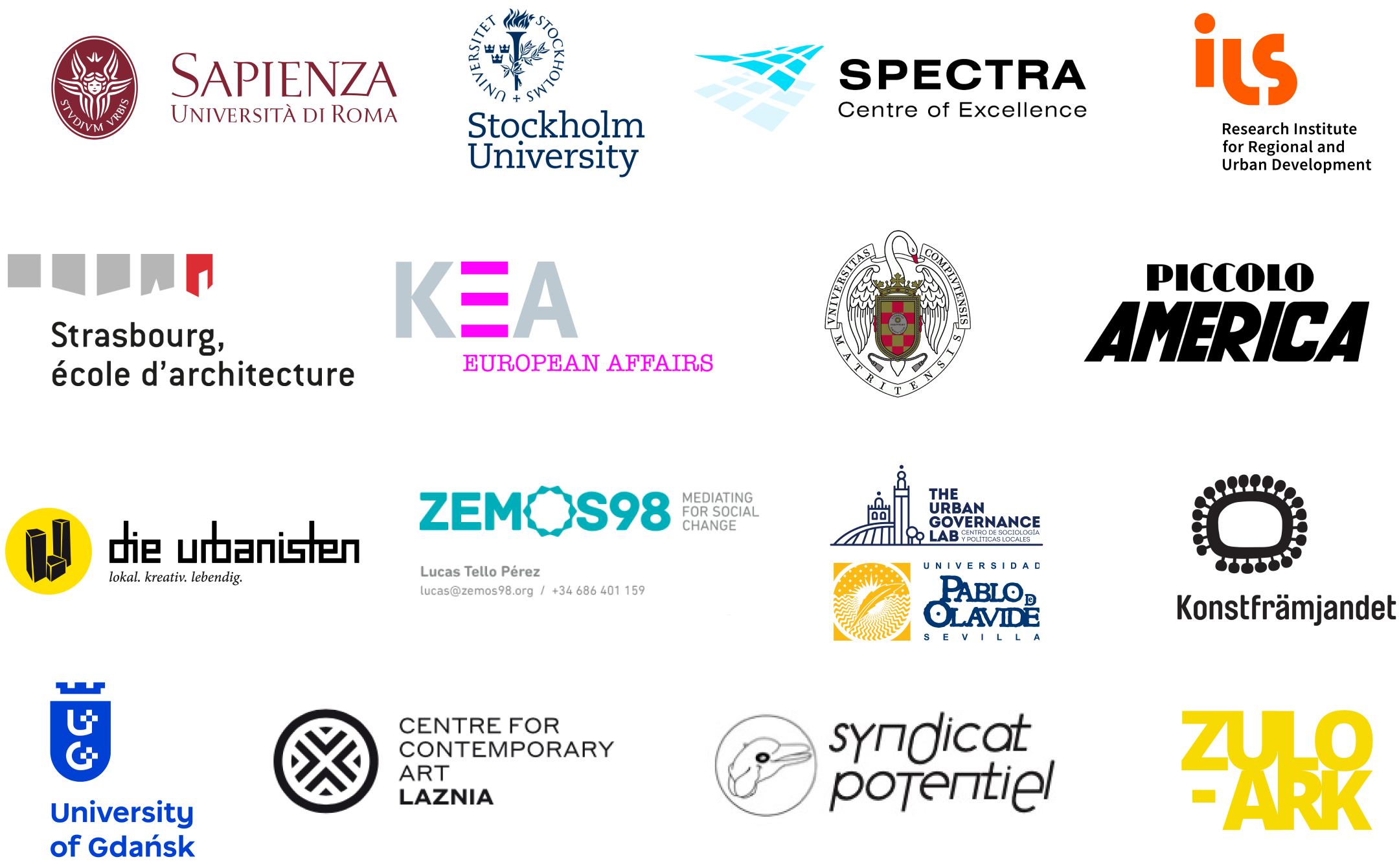WP1 – Conceptual background: from theoretical principles to an operational framework
Objectives
WP1’s general purpose is to draw up a conceptual research framework for the project and providing a methodological field research agenda (particularly for WP2, WP3 and WP4).
WP1 aims to:
- Define a common glossary between the different disciplines and cultural creative fields as a basis for a shared integrated and multidisciplinary research work.
- Undertake a theoretical review of the literature, analysing the project’s main concepts, and historical background, identifying and discussing available data, and methodology to define a theoretical framework.
- Develop a conceptual research framework for the project focusing on participatory co-creation and co-designing processes to conceptualise and implement place-based and evidence-based responses to current challenges for urban transitions.
Draw up a joint research agenda to provide indicators for the mapping and case studies selection criteria, defining research instructions for case studies analysis and small-scale trials supporting WP2, WP3 and WP4.
List of Deliverables
- D1.1 Theoretical research framework
- D.1.2 Conceptual research framework
- D.1.3 Methodologic al field research agenda and research instructions
- D1.4 Data Management Plan
WP2 – Mapping and selecting cases
Objectives
The aim of this work package is to map all praesidia in all case study cities, and from the resulting maps select a sample of 12-15 praesidia that will be investigated as case studies (in WP3). The selection of the sample will be based on criteria developed within WP1. The overall methodological idea is to get a varied sample, that has been informed by spatial indicators (e.g. central/peripheral district, type of district). A further methodological strength is that the selection is made in relation to all possible cases within the case study city. In addition, the work with mapping and selecting will inform the development of the map application Praesidia Guide.
List of Deliverables
- D2.1 Search terms and maps
- D2.2 Selection of case studies
- D2.3 Best practice of API cultural mapping
WP3 – Case Studies on local cultural praesidia
Objectives
The objectives of this work package are:
To collaborate with professionals, entrepreneurs, and stakeholders of local cultural praesidia for the research agenda. To coordinate fieldwork in the case studies and ensure high-quality inputs for WP 4 (trials and practical interventions) and WPs 5-6-7 comparative analysis and research reports.
To systematically explore the challenges and resources of local cultural praesidia in case study cities through comparative empirical research (analysing 12-15 praesidia in each case study city).
List of Deliverables
- D3.1 Guidelines for case study research
- D3.2 Final case study area reports submitted.
WP4 – Co-creation and co-design process trials: participative knowledge development and learning by
Objectives
The objectives of WP4 are as follows:
Evaluating the effectiveness of the co-creation framework and make iterative refinements based on the lessons learned and emerging best practices.
Conceptualising trials within creative placemaking and linking it to EU urban priorities.
Creating and re-sharing the conceptual base by integrating new ideas into the practical implications.
Using the process of practical implications for participative deriving innovative solutions and knowledge.
Facilitating clear channels for effective communication and collaboration among stakeholders of trials.
Providing training sessions and resources to build the capacity of participants in co-creation and co- design methodologies.
Ensuring representation of diverse perspectives in the co-creation and co-design process.
List of Deliverables
- D4.1 Guidelines for trials
- D4.2 Tool-kit for trials
WP5 – Spatial processes, urban design and reuse practices
Objectives
Objectives are as follows:
To analyse and understand from a comparative perspective how reuse practices contribute to the emergence of new territories, as well as new actors (collaborating with the cultural milieu to implement cultural projects). To provide evidence, based on cases and trials (in WP 3 and WP4), on socio-spatial innovations, implementing urban co-design approaches and the use of sustainable and recycled materials.
To analyse the spatial dimension (including the architectural, urban and landscape dimensions) of each case study in relation to the social and spatial interactions that it generates in the local cultural ecosystem, including questions of belonging.
List of Deliverables
- D.5.1 Cartographic and photographic atlas
- D.5.2 Socio-spatial typologies
WP6 – Policy and governance – supporting NEB initiatives across Europe
Objectives
Identify key principles in activities, networks and platforms of NEB and NEB-like projects throughout Europe.
Comparative analysis of all case studies and trials conducted in WP3 and WP4 regarding policy and governance in creative placemaking.
Multilevel (local to EU-level) analyses of context-dependent promoting and inhibiting factors within policy and governance across Europe with the aim to distil success factors that enable innovation and transformative practices that actually contribute to (local) economic development, sustainability, social cohesion and identity. Synthetise all data into an evidence-informed framework for policy transfer of local NEB initiatives across Europe based on comparative and synthesizing analysis of all cases and trials from a policy and governance perspective, for WP 8.
List of Deliverables
- D6.1 Innovation in creative placemaking
- D6.2 Proactive and transferable framework of policy and governance measures
WP7 – Social, economic and environmental consequences
Objectives
WP7 aims to provide evidence about the social, economic and environmental effects of NEB experiences, analysed through cases and trials, and the factors explaining them. Conceptual and operational definitions of the effects of local cultural praesidia and their potential explaining factors will be developed in WP1. WP7 will apply these analytical ideas to study the information collected in cases and trials (in WP3 and WP4) from a comparative perspective to provide comparative evidence. Specifically, this WP will try to evaluate the effects of NEB experiences by analysing changes in the three main dimensions of urban sustainable development (social, economic, environmental).
List of Deliverables
- D7.1 Comparing local cultural praesidia effects on community sustainable development
- D7.2 Validating evaluation assessment in real trials
- D7.3 Cases cross-evaluation
- D7.4 How to evaluate NEB initiatives’ effects
WP8 – Policy analyses, synthesis and recommendations
Objectives
The main objective of WP8 is to translate gained knowledge into an NEB-oriented transformative framework of creative placemaking, including principles, strategies, policies, tools and processes helpful in stimulating and accompanying sustainable transition pathways in CCIs and cultural heritage. WP8 main objectives:
Organise an Innovation Camp to validate our research findings and the transformative framework with creative placemakers and policy-makers communities;
Synthesise research results which come from WP 5, 6, 7, with the empirical findings (WP3) and trials realised under real-world conditions (WP4);
Provide evidence-based policy recommendations at different levels of government in the EU;
Deliver a flexible, adaptable and transferable context-sensitive NEB-oriented transformative framework of creative placemaking. This aspect will integrate existing proofs in EU projects and achievements in the NEB movement to emerging evidence from on-ground research and small-scale trials developed in WP3-WP4;
List of Deliverables
- D8.1 New theoretical framework
- D8.2 Innovation Camp
- D8.3 NEB-oriented transformative framework
WP9 – Communication, Dissemination and Exploitation
Objectives
The objective of this WP is to ensure the visibility of the project, raise awareness about its achievements at European and local levels, facilitate knowledge sharing, and maximize the practical exploitation and impact of the project outcomes in the long-term. The specific objectives of WP9 are:
Set up systematic exploitation processes for project results to ensure the project’s long-term sustainability and that of its community.
To ensure project visibility and raise awareness of its outcomes by effectively coordinating communication and dissemination activities, alongside coordinating and guiding communication efforts at consortium level.
To manage, enlarge, and sustain the STARTUP community by bringing together relevant stakeholders and actively engaging with the NEB Community and local communities through strategic communication activities and events.
Promote knowledge exchange and best practices both at EU and local level and within the NEB community, while fostering policy dialogue with EU-level authorities.
List of Deliverables
- D9.1 Project Communication, Dissemination & Exploitation Strategy
- D9.2 Project Visual Identity & Website
- D9.3 Communication, Dissemination & Exploitation activities. Report and Revision of the strategy – Year 1
- D9.4 Communication, Dissemination & Exploitation activities. Report and Revision of the strategy – Year 2
- D9.5 Communication, Dissemination & Exploitation Final Report
- D9.6 Report on Community Engagement
- D9.7 Report on Final Conference
WP10 – Project Management
Objectives
The objective of the management activities is to ensure the successful execution of the project by:
Regulating communication between the EC and the consortium Overseeing that project activities comply with planned activities and that deadlines for deliverables and milestones are respected.
Setting up an efficient management structure with clear rules for the decision-making processes and governing bodies
Providing administrative support to the partners, including on financial matters
Promoting collaboration between partners
List of Deliverables
- D10.1 Kick off meeting
- D10.2 Project Management guidelines
- D10.3 Meetings of the Steering Committee and Project meetings


